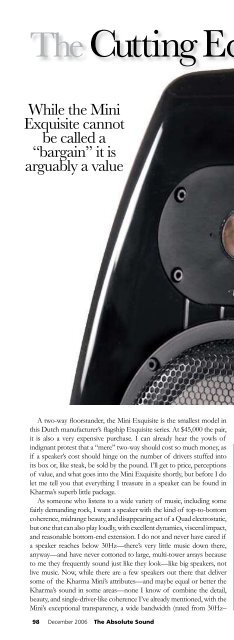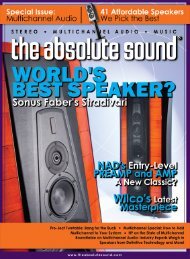You also want an ePaper? Increase the reach of your titles
YUMPU automatically turns print PDFs into web optimized ePapers that Google loves.
The Cutting Edge<br />
While the Mini<br />
Exquisite cannot<br />
be called a<br />
“bargain” it is<br />
arguably a value<br />
A two-way floorstander, the Mini Exquisite is the smallest model in<br />
this Dutch manufacturer’s flagship Exquisite series. At $45,000 the pair,<br />
it is also a very expensive purchase. I can already hear the yowls of<br />
indignant protest that a “mere” two-way should cost so much money, as<br />
if a speaker’s cost should hinge on the number of drivers stuffed into<br />
its box or, like steak, be sold by the pound. I’ll get to price, perceptions<br />
of value, and what goes into the Mini Exquisite shortly, but before I do<br />
let me tell you that everything I treasure in a speaker can be found in<br />
Kharma’s superb little package.<br />
As someone who listens to a wide variety of music, including some<br />
fairly demanding rock, I want a speaker with the kind of top-to-bottom<br />
coherence, midrange beauty, and disappearing act of a Quad electrostatic,<br />
but one that can also play loudly, with excellent dynamics, visceral impact,<br />
and reasonable bottom-end extension. I do not and never have cared if<br />
a speaker reaches below 30Hz—there’s very little music down there,<br />
anyway—and have never cottoned to large, multi-tower arrays because<br />
to me they frequently sound just like they look—like big speakers, not<br />
live music. Now, while there are a few speakers out there that deliver<br />
some of the Kharma Mini’s attributes—and maybe equal or better the<br />
Kharma’s sound in some areas—none I know of combine the detail,<br />
beauty, and single-driver-like coherence I’ve already mentioned, with the<br />
Mini’s exceptional transparency, a wide bandwidth (rated from 30Hz–<br />
100kHz) that starts with an impressive bottom end reach and impact<br />
and finishes with glorious, diamond-tweeter-born highs, and the ability<br />
to disappear as well as any speaker I’ve heard. (Another great Mini, from<br />
MAGICO, offers much of what the Kharma does, but it is, at least to<br />
the degree I’m familiar with it, not as breathtakingly beautiful as the<br />
Kharma is. Both are highly detailed, the MAGICO may be even more<br />
dynamic, but the bass of these two speakers couldn’t be more dissimilar.<br />
Beyond driver differences, the MAGICO’s enclosure is sealed and the<br />
Kharma’s is ported. As listeners who have heard both can attest, these<br />
different ways of loading the bass contribute mightily to each sonic<br />
signature.) Let me also add that to me the term “transparency” does not<br />
simply mean that a speaker is especially clear, though that’s part of it,<br />
and it’s not just about resolution, though that, surely, is part of it, too;<br />
what it means to me is a component is a transparent window to the source.<br />
In the case of a speaker—and this speaker to the max—this means<br />
starting at the binding posts through to the speaker cables and on to the<br />
power amp and so on, all the way back to the information encoded in a<br />
CD or cut into the surface of a vinyl platter.<br />
Consider Libra, from the great sounding Decca LP of English<br />
composer Roberto Gerhard’s Astrological Series: Libra-Gemini-Leo. As<br />
heard through the Kharma (along with the components listed below),<br />
the players in the London Sinfonietta—flute, piccolo, clarinet, violin,<br />
98 December 2006 The Absolute Sound










